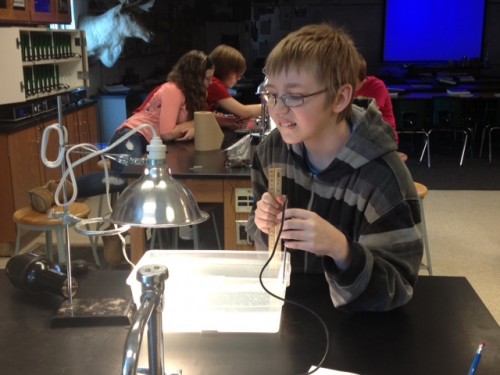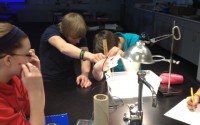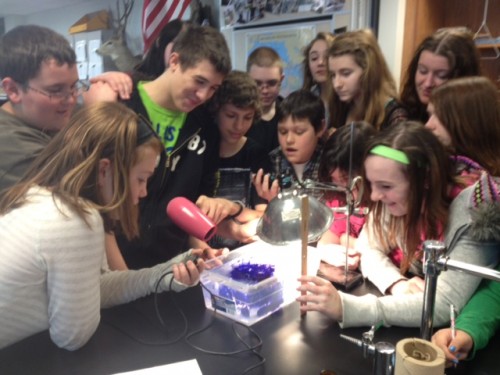Ever wonder why when you dive in a lake, there is a sudden drop in temperature? Russ Stolberg’s 8th grade Earth Science students have been discussing why we observe this phenomenon in our lakes and oceans. It all has to do with density! Cold water has a higher density than warmer water, and as solar radiation continually warms the surface of our lakes it makes this separation even more pronounced. I [Jake] had the pleasure working with the students on an exciting lab simulating how waters can become  layered, or stratified, and then simulate how this stratification can be broken down through natural processes. Groups of students each got to work with their own pond (a clear plastic tub), which was heated by the sun (a heat lamp) and received warm wind via a blow dryer. We started with “Winter” conditions, where the entire water body was cold water. As we moved into “Spring” and “Summer” the heat from the sun began warming the surface waters. Students recorded the temperature of the water at several depths to observe how the temperatures changed over a 30-minute period. Students witnessed how the warm waters sat on top of the cold waters with a distinct separation of the cold and warm water forming, or what is called a thermocline. Then as “Autumn” approached the winds picked up, blow dryers were set to High, and the aid of a blue crystal dye, we were able to visualize a lake turnover event as the warm, dyed water from the surface was forced to the bottom of the lake via strong winds. Students recorded the temperature of the different depths one final time, observing that the thermocline that had formed had disappeared through the mixing event.
layered, or stratified, and then simulate how this stratification can be broken down through natural processes. Groups of students each got to work with their own pond (a clear plastic tub), which was heated by the sun (a heat lamp) and received warm wind via a blow dryer. We started with “Winter” conditions, where the entire water body was cold water. As we moved into “Spring” and “Summer” the heat from the sun began warming the surface waters. Students recorded the temperature of the water at several depths to observe how the temperatures changed over a 30-minute period. Students witnessed how the warm waters sat on top of the cold waters with a distinct separation of the cold and warm water forming, or what is called a thermocline. Then as “Autumn” approached the winds picked up, blow dryers were set to High, and the aid of a blue crystal dye, we were able to visualize a lake turnover event as the warm, dyed water from the surface was forced to the bottom of the lake via strong winds. Students recorded the temperature of the different depths one final time, observing that the thermocline that had formed had disappeared through the mixing event.  Below is a copy of the lab protocol. Any follow-up questions can be directed to Jake at nalleyja@msu.edu.
Below is a copy of the lab protocol. Any follow-up questions can be directed to Jake at nalleyja@msu.edu.
By GK-12 Fellow Jakob Nalley, 2013

